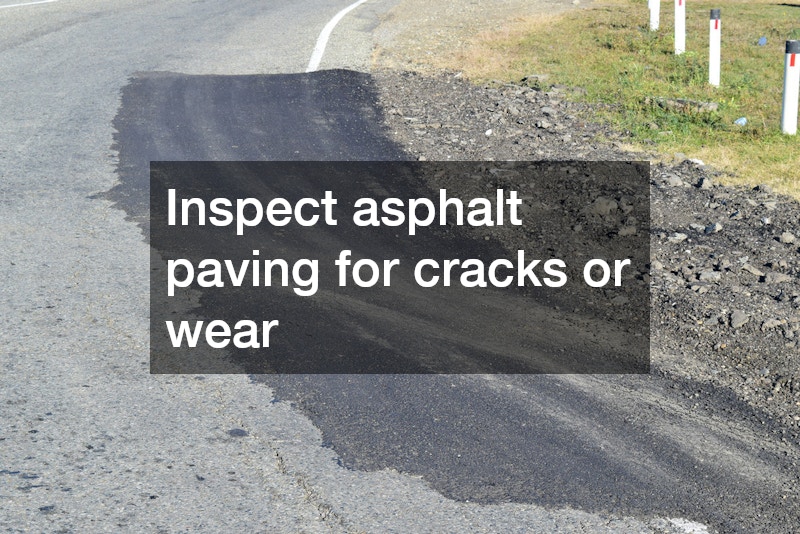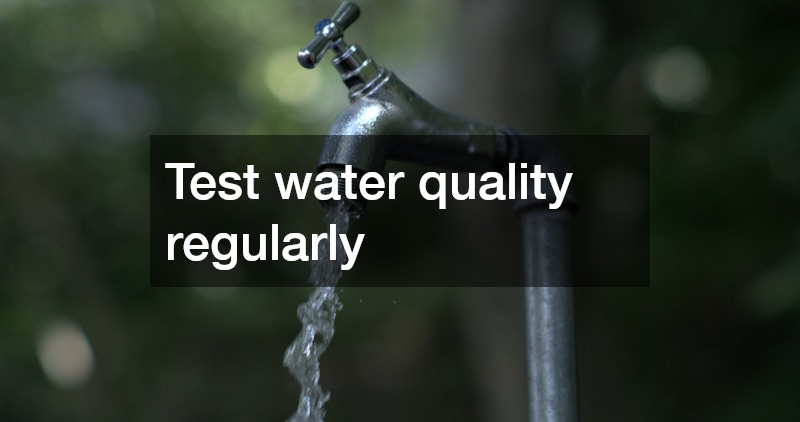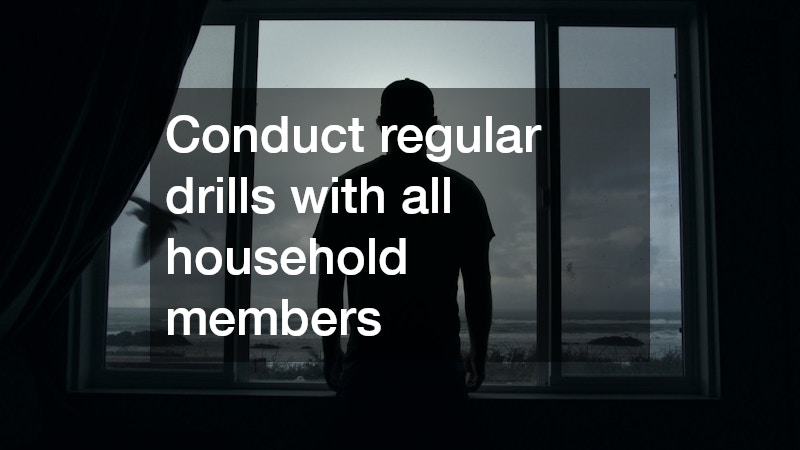Living off-grid is an increasingly popular lifestyle choice for homeowners seeking independence, sustainability, and resilience against power outages or supply disruptions. However, creating a fully self-sufficient property requires meticulous planning, careful execution, and ongoing maintenance. From water and heating to waste management and infrastructure, each element of an off-grid home must work seamlessly to ensure safety, comfort, and long-term functionality.
This guide provides a comprehensive checklist for establishing a self-sufficient property. It covers essential systems like water sourcing, heating, sanitation, and structural preparations while incorporating practical tips and professional guidance. By following this roadmap, homeowners can reduce risks, optimize efficiency, and enjoy the confidence that comes with a resilient off-grid setup.
Water Well Drilling Companies and Well Pump Installation
A reliable water source is the foundation of any off-grid property. Access to clean water ensures your family’s health, supports sanitation, and allows other systems, such as heating and irrigation, to function effectively. Many homeowners turn to water well drilling companies to establish safe, sustainable wells that meet both current and future water demands.
Professional well drilling services are vital because they help identify groundwater levels, ensure proper well placement, and prevent contamination from nearby septic systems or surface runoff. Drilling companies can also recommend appropriate casing, depth, and materials to maximize water quality and longevity.
Once the well is in place, proper well pump installation ensures consistent water flow throughout your property. Pumps vary depending on your well’s depth and output requirements. Submersible pumps are ideal for deep wells, while jet pumps may suffice for shallower sources.
Tips for homeowners:
-
Conduct a property survey to determine the best location for the well. Avoid low-lying areas where flooding may affect water quality.
-
Test water quality before finalizing installation to ensure it meets safety standards.
-
Consider redundancy by installing a backup pump or power source.
-
Schedule regular inspections and maintenance to prevent mechanical failures and ensure long-term performance.
By working with professionals for drilling and pump installation, homeowners can establish a water system that reliably supports everyday living, irrigation, and emergency needs.
Water Purification Supplies and Catch Basin Installer
Even with a properly drilled well, water may contain impurities such as bacteria, sediment, or mineral deposits. Using high-quality water purification supplies is essential for maintaining safe drinking water and supporting other domestic uses. Options include carbon filters, reverse osmosis units, UV purifiers, and chemical treatments. The right choice depends on water quality, household size, and usage requirements.
In addition to clean water, managing stormwater and runoff is critical to prevent flooding, erosion, and damage to your home’s foundation. Hiring a professional catch basin installer ensures that your property efficiently channels water away from living spaces, gardens, and infrastructure. Catch basins collect excess water and direct it to drains, retention areas, or irrigation systems, protecting both the home and landscape.
Practical advice for homeowners:
-
Test water quality regularly to determine which purification systems are necessary.
-
Maintain and replace filters according to manufacturer recommendations.
-
Inspect catch basins for debris, especially after storms, to maintain proper drainage.
-
Integrate water management systems with irrigation or rainwater collection where possible.
By combining water purification with effective stormwater management, homeowners can secure a safe and sustainable water supply for an off-grid lifestyle.
Heater Oil Delivery and Propane Cylinders
Maintaining a reliable heating system is crucial for off-grid homes, especially in regions with cold winters. While some homes rely on renewable energy sources, many off-grid properties supplement or fully use fuel-based heating options. Heater oil delivery services provide a steady supply of heating oil for oil-fired furnaces, ensuring your home stays warm even when electricity is unavailable.
Similarly, propane cylinders offer versatile energy for heating, cooking, and backup power. Propane is portable, relatively easy to store, and can power a variety of appliances, making it an essential component of an off-grid energy plan.
Homeowner considerations:
-
Calculate annual consumption to determine how many deliveries or cylinders are needed.
-
Store propane cylinders in ventilated, secure locations away from living areas.
-
Schedule fuel deliveries ahead of peak seasons to avoid shortages.
-
Consider dual-fuel setups to provide redundancy if one system fails.
-
Regularly inspect tanks, lines, and connections to prevent leaks or safety hazards.
Integrating heater oil and propane solutions ensures warmth, comfort, and operational flexibility, crucial for off-grid living.
Sewer Inspection and Waste Management Planning
Sanitation is one of the most critical aspects of off-grid living. Without access to municipal sewer systems, homeowners must take full responsibility for managing waste in a way that protects both human health and the surrounding environment. Effective waste management prevents contamination of drinking water, reduces unpleasant odors, and ensures that your property remains clean and habitable. Central to this process is conducting regular sewer inspections and maintaining systems like septic tanks, composting toilets, or other alternative waste management solutions.
The Importance of Regular Sewer Inspections
Septic systems are the backbone of off-grid sanitation for many homes. These systems rely on tanks, leach fields, and piping to treat and dispose of wastewater safely. Without regular inspections, issues like blockages, leaks, or system failures can develop unnoticed, potentially contaminating groundwater and causing expensive property damage. Professional inspections identify early signs of trouble—such as uneven drainage, unusual odors, or slow flushing—allowing for timely repairs before minor issues escalate into major problems.
Regular sewer inspections are also essential for alternative systems like composting toilets or greywater setups. Ensuring that tanks, compost chambers, and drainage pipes are functioning correctly protects against health hazards and keeps these systems efficient.
Tips for Homeowners to Maintain Waste Systems
1. Schedule Annual Sewer Inspections
-
Hire a licensed professional to inspect your septic system or alternative waste solutions at least once per year.
-
Include both tanks and leach fields in inspections to catch potential blockages or leaks early.
-
Request a written report detailing any concerns or recommended maintenance tasks.
2. Use Systems Properly to Avoid Damage
-
Avoid flushing non-biodegradable items, chemicals, or excessive grease into septic systems. These substances can clog pipes and disrupt bacterial activity that breaks down waste.
-
Follow manufacturer guidelines for composting toilets, including proper use of additives and maintenance routines.
-
Educate all household members on best practices to protect the system from misuse.
3. Keep Emergency Contact Information Handy
-
Maintain a list of local septic service providers, plumbers, or waste management professionals for quick response to urgent issues.
-
Include contact information for nearby suppliers of replacement parts, pumps, or chemicals needed for system maintenance.
-
Knowing who to call in an emergency reduces downtime and prevents further damage.
4. Maintain a Detailed Maintenance Log
-
Record all inspections, repairs, and maintenance activities in a dedicated logbook.
-
Include dates, service providers, and work performed to track patterns and anticipate future maintenance needs.
-
This log is also valuable for insurance purposes or when selling the property, demonstrating that systems have been properly maintained.
5. Coordinate Waste Management with Other Off-Grid Systems
-
Properly position septic tanks, leach fields, and drainage systems in relation to water wells and catch basins to prevent contamination.
-
Ensure that surface water from rain or irrigation is diverted away from septic areas to prevent oversaturation.
-
Combine waste system planning with paving, sand stabilization, and stormwater management for long-term efficiency.
Benefits of Proper Waste Management Planning
When waste systems are carefully maintained and integrated with other off-grid systems, homeowners enjoy multiple benefits:
-
Health and Safety: Reduces the risk of waterborne illnesses and environmental contamination.
-
Property Protection: Prevents costly repairs due to leaks, backups, or failed components.
-
System Longevity: Regular inspections and proper use extend the life of septic and alternative waste systems.
-
Operational Efficiency: Coordinated planning with other systems like wells, drainage, and catch basins ensures the property functions smoothly.
Local Asphalt Paving and Sand Supplier
Infrastructure is often overlooked when planning an off-grid property, but it is crucial for accessibility, maintenance, and long-term sustainability. Local asphalt paving provides durable driveways and access roads, allowing vehicles to reach wells, fuel storage, and homes even during heavy rain or snow. Well-maintained paved areas also reduce erosion and prevent muddy conditions that can damage vehicles and equipment.
A reliable sand supplier is equally important for construction, leveling, and drainage projects. Sand can stabilize roads, create foundations, fill low-lying areas, or serve as bedding for septic systems and water infrastructure.
Actionable steps:
-
Design access roads for the heaviest vehicles that will use them regularly.
-
Choose asphalt thickness and base materials appropriate for climate and traffic conditions.
-
Source sand from reputable suppliers to ensure consistency and avoid contamination.
-
Maintain paved surfaces and top up sand as needed to prevent erosion or settling.
By investing in proper paving and sand resources, off-grid homeowners can protect their infrastructure and support all other systems efficiently.
Storm Shelter and Emergency Preparedness
Severe weather poses unique risks for off-grid properties, where emergency services may be less accessible. Installing a storm shelter provides a safe haven during tornadoes, hurricanes, or extreme weather events. Shelters should be easily accessible from the main living area, structurally sound, and equipped with ventilation, lighting, and emergency supplies.
Key recommendations:
-
Choose a storm shelter location that is both convenient and protected from flooding.
-
Equip the shelter with emergency lighting, first aid supplies, water, and communication devices.
-
Conduct regular drills with all household members to ensure everyone knows how to reach the shelter quickly.
-
Inspect the shelter periodically for structural integrity and water tightness.
A storm shelter, combined with a proactive emergency plan, provides both peace of mind and a tangible safeguard against unpredictable weather.
Integrating Systems for Maximum Efficiency
An off-grid property achieves its full potential only when all systems—water, heating, waste management, and infrastructure—are thoughtfully coordinated. Integration is more than just placing each system in its proper location; it involves designing connections, redundancies, and workflows so that the property operates smoothly with minimal downtime. Proper integration ensures that water flows where it is needed, heating and fuel are reliably available, waste is properly managed, and infrastructure supports all operations efficiently.
For instance, well pumps should be strategically located to complement catch basins and water purification systems. Placing the pump too far from the storage tank or purification unit can reduce efficiency and increase energy costs. Similarly, fuel storage for heating, including propane cylinders and heater oil tanks, should be accessible for deliveries yet safely isolated from living areas and other critical systems to minimize hazards. Well-planned positioning of infrastructure elements like paved roads, sand-filled areas, and storm shelters ensures smooth access, proper drainage, and long-term stability.
Key Strategies for System Integration
1. Map Systems During the Planning Phase
Before construction or installation begins, create a detailed map of all systems on your property. This visualization helps identify potential conflicts and ensures that components like water lines, fuel storage, drainage systems, and roads are optimally placed. Consider proximity, ease of access for maintenance, and safety when arranging each system.
2. Optimize Fuel and Heating Layouts
Heating systems often rely on propane or oil. Position propane cylinders and heater oil tanks so that deliveries are straightforward, refills are safe, and emergency access is easy. Avoid placing tanks near electrical equipment, living areas, or areas prone to flooding. Proper separation and containment reduce the risk of accidents, leaks, or fire hazards.
3. Coordinate Drainage, Paving, and Sand Usage
Infrastructure elements should support water management and system maintenance. Use local asphalt paving to create durable roads and driveways that provide access to critical systems during all weather conditions. Work with a sand supplier to stabilize foundations, support drainage systems, and prevent erosion near wells, septic areas, or catch basins. Well-coordinated placement ensures water flows efficiently, roads remain navigable, and access to maintenance points is never blocked.
4. Build Redundancy into Critical Systems
Off-grid living requires contingency planning. Incorporate redundancies in vital systems such as water, heating, and energy supply to prevent downtime. Examples include:
-
Backup pumps to maintain water flow if the primary pump fails.
-
Dual-fuel heating options, combining propane and oil to ensure warmth during emergencies.
-
Auxiliary water storage tanks to provide a buffer during maintenance or shortages.
Redundancy ensures that a single failure does not disrupt overall functionality and reduces stress on homeowners.
5. Maintain Accessibility and Efficiency
Integration also involves planning for maintenance and long-term usability. Systems should be accessible for inspections, repairs, or seasonal adjustments without interfering with one another. For example, catch basins and stormwater systems should be reachable for cleaning without disturbing water purification or well infrastructure. Roads, paving, and sand placement should facilitate access to heating, water, and waste systems, rather than obstruct it.
Benefits of Integrated Systems
When systems are effectively integrated, homeowners experience numerous advantages:
-
Operational efficiency: Water, heating, and waste systems function smoothly with minimal manual intervention.
-
Reduced stress: Clear organization and accessible components make troubleshooting and maintenance simpler.
-
Enhanced resilience: Redundant systems and coordinated layouts minimize the impact of equipment failures or extreme weather.
-
Long-term sustainability: Properly planned integration reduces wear, maximizes resource efficiency, and prolongs the lifespan of infrastructure and equipment.
Thoughtful integration transforms an off-grid property from a collection of individual systems into a cohesive, self-sustaining home.
Maintenance Checklist and Seasonal Considerations
Even the most well-planned off-grid property requires ongoing maintenance to remain functional and safe. Establishing a regular checklist ensures that all systems—from water and heating to sanitation and infrastructure—are inspected and maintained according to seasonal needs.
Water Systems:
-
Test water quality quarterly.
-
Clean and inspect well pumps and water purification equipment.
-
Check catch basins for debris and proper flow.
Heating:
-
Schedule propane cylinder checks and refill deliveries before winter.
-
Inspect heater oil tanks, lines, and burners for leaks or damage.
Waste Management:
-
Conduct sewer inspections and septic system maintenance.
-
Monitor leach fields and catch basins for proper operation.

Infrastructure:
-
Inspect asphalt paving for cracks or wear.
-
Replenish sand for leveling or drainage projects.
-
Examine storm shelters for leaks, structural issues, and emergency supplies.
Maintaining detailed records of inspections, repairs, and professional service visits ensures that your off-grid home remains fully operational throughout the year.
Setting up an off-grid home requires careful planning, professional guidance, and consistent maintenance. By addressing water access with well drilling, pump installation, and purification, ensuring reliable heating with propane cylinders and heater oil delivery, managing waste through sewer inspections and catch basins, and building durable infrastructure with asphalt paving, sand, and storm shelters, homeowners can create a safe, resilient, and self-sufficient property.
Following a structured checklist not only protects your investment but also enhances comfort, security, and peace of mind, allowing you to fully embrace the freedom and independence of off-grid living.



